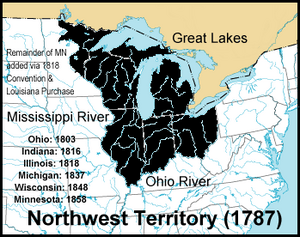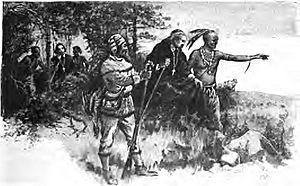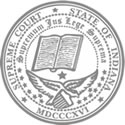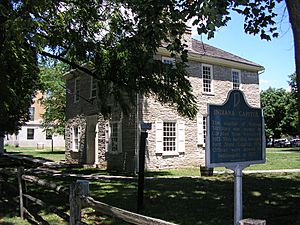Polly Strong facts for kids
Quick facts for kids
Polly Strong
|
|
|---|---|

Drawing of Polly Strong, who sued for her freedom in 1820, Indiana
|
|
| Born | ca. 1796 |
| Died | Unknown |
| Known for | State v. Lasselle, Supreme Court of Indiana freedom suit case |
Polly Strong (born around 1796) was an enslaved woman in the Northwest Territory, which is now Indiana. She was born after a law called the Northwest Ordinance said slavery was not allowed there. Later, in 1816, the Constitution of Indiana also banned slavery.
Despite these laws, Polly remained enslaved. In 1818, her mother, Jenny, and a lawyer named Moses Tabbs tried to get Polly and her brother James freed. They asked the court for a writ of habeas corpus, which is a legal way to ask why someone is being held. The judge said Polly had to serve 12 more years and James four more. Their case was dismissed in 1819.
However, in 1819, new lawyers, John W. Osborn and Amory Kinney, decided to challenge slavery in court. They filed a lawsuit for Polly's freedom in 1820, called Polly v. Lasselle. The first court said she should stay enslaved. But they appealed the case to the Indiana Supreme Court, calling it State v. Lasselle.
Based on the 1816 Constitution of Indiana, the judges ruled that "slavery can have no existence" in Indiana. Polly Strong was finally freed! This decision did not automatically free all enslaved people, but it set an important example. Others could now use this court ruling to fight for their own freedom. In 1821, another case, Mary Clark v. G.W. Johnston, made indentured servitude illegal too. Over time, the number of enslaved people in Indiana greatly decreased.
Contents
Slavery in Indiana's Past
Before Indiana became a state, enslaved African and Native American people were held by French traders and priests. This practice continued even when Great Britain controlled the area. In 1787, the land north and west of the Ohio River became the Northwest Territory.
A law called the Northwest Ordinance was passed that year. It said that slavery and forced labor were not allowed. However, many slaveholders thought this law only applied to new slaves, not those they already owned.

In 1800, the Indiana Territory was created. Many slaveholders moved there, bringing their enslaved people with them. The territory then passed laws that allowed people to be held as indentured servants. This meant slaveholders could keep people they had bought outside the territory, even if they moved to Indiana.
When Indiana became a state in 1816, its new Constitution completely banned slavery and forced labor. This ban created problems with the older laws that had allowed slavery. So, the courts had to decide many times if old slavery arrangements were still legal. Each time, local courts made different decisions. Even after 1816, some Black people remained enslaved or as indentured servants. In 1820, there were 190 enslaved people in Indiana, with 118 of them in Knox County, Indiana.
A historian named Paul Finkelman explained three ways enslaved people in Indiana could become free. They could run away, hire lawyers to file freedom suits in court, or their owners could choose to free them.
Polly's Early Life
Polly Strong was born around 1796 in the Northwest Territory. Her mother, Jenny, was an enslaved woman owned by Antoine Lasselle, who lived near Fort Wayne. Polly's father had the last name Strong.
Before Polly was born, her mother Jenny was kidnapped by Native Americans. She was later sold to Antoine Lasselle after a peace agreement called the Treaty of Greenville in 1795. Polly's brother, James, was born around 1800.
Polly and James were separated. Polly was sold to Joseph Barron. James was later sold to someone named LaPlante. When Polly was about ten, she was bought by Hyacinthe Lasselle. He was an innkeeper and trader from Vincennes, in what was then the Indiana Territory. Lasselle later bought James too, bringing the siblings back together.
Polly was baptized on April 11, 1819, at a church in Vincennes. She was given the name Marguerite and was described as a mixed-race woman. It seems she was not treated well by Lasselle. Polly was known for being pretty with a "bright disposition" and "pleasing manners."
After the first attempt to free them, Polly and James were threatened and held captive by Lasselle. On January 9, 1820, Polly found safety with Joseph Huffman, an African American barber. Huffman was later accused of "harboring a servant girl." He paid a bond to help Polly get released from Lasselle.
The Lasselle Family
The Lasselles were one of the oldest families of European settlers in Indiana. They had been in the region since France owned it in the 1700s. Hyacinthe Lasselle moved to Vincennes in 1804. He held important jobs in the government and community. He ran an inn, a bar, and a place that made alcohol. He also fought in the War of 1812.
Vincennes was an early French settlement where people bought enslaved individuals to help with daily tasks. Lasselle bought his enslaved people from Native Americans. When the state constitution was passed, he pretended to free his slaves, but they were not truly free.
Polly's Fight for Freedom
First Court Attempt: Habeas Corpus
Even though the 1816 Indiana Constitution banned slavery, Polly Strong remained enslaved. On July 15, 1818, Moses Tabbs, a lawyer working with Polly's mother Jenny, asked the Knox County Circuit Court for a writ of habeas corpus. This was for Jenny, Polly (who was 22), and James (who was 15).
Lasselle had to go to court to explain why Jenny's two children should remain enslaved. On August 4, 1818, Judge Thomas H. Blake met with Lasselle, Polly, and James. The judge showed papers that said Polly had to serve 12 more years and James four more. Polly and James were forced to agree that their service to Lasselle was voluntary. During this time, Lasselle threatened and imprisoned them when they signed these papers. The case of James and Polly vs. Lasselle was dismissed in May 1819. After this, James did not appear in any more habeas corpus cases.
Polly v. Lasselle
In 1819, two abolitionists, John W. Osborn and Amory Kinney, wanted to challenge the legality of slavery arrangements made before 1816. They were Canadians who had moved to Indiana after the War of 1812. They believed that the state's ban on slavery should apply to everyone, even those enslaved before 1816.
Lawyers George McDonald and Moses Tabbs, who also opposed slavery, began preparing a test case. Polly had been bought before the Northwest Territory was even created. If she could be freed, it would set an example for all other enslaved people in the state. Her case was combined with a similar one for an enslaved man named Francis Jackson.
On January 27, 1820, lawyer Amory Kinney filed a freedom suit for Polly with the Knox County Circuit Court. Lasselle's lawyer was Judge Jacob Call. The local court in Vincennes decided that Polly should remain enslaved. They reasoned that since Polly's mother was enslaved before the Northwest Ordinance of 1787, her mother remained a slave. The judges said that the rule where children of enslaved women were also enslaved should apply here.
State v. Lasselle: The Big Win
Kinney appealed the decision to the Indiana Supreme Court in Corydon, Indiana. This appeal was filed on May 12, 1820. Amory Kinney, George McDonald, and Moses Tabbs represented Polly Strong. John W. Osborn, Kinney's law partner, was also involved.
The lawyers arguing for Polly said that the Indiana Constitution was the highest law. They argued it should overrule any older laws, including those from before Indiana became a state. They also said the Northwest Ordinance no longer applied to Indiana after it became a state. The defense lawyers argued that the Northwest Ordinance was a federal law. They said it was still in effect and was more powerful than the state constitution.
The court made its decision on July 22, 1820. They based their ruling on the Indiana Constitution, Article 11, Section 7, which states:
There shall be neither slavery nor involuntary servitude in this state, otherwise than for the punishment of crimes, whereof the party shall have been duly convicted. Nor shall any indenture of any negro or mulatto hereafter made, and executed out of the bounds of this state be of any validity within the state."
Justice James Scott wrote that the people who created the constitution clearly wanted to completely ban slavery in Indiana. He said they could not have made their intention any clearer. Polly Strong was declared a free woman!
Lasselle tried to appeal the decision to the Supreme Court of the United States on July 27, 1820. However, the highest court in the country refused to hear the case. This meant the Indiana Supreme Court's decision stood.
What the Decision Meant
This ruling was a huge victory for people who wanted to end slavery in Indiana. Polly was free, but the decision did not automatically free all other enslaved people. However, it made the Indiana Constitution the main rule for all court decisions about slavery and forced labor in Indiana.
Some slaveholders were angry and even threatened the lawyers Osborn and Kinney, but no harm came to them. The case also led to a local judge being removed from his job for helping slaveholders who refused to free their enslaved people. Many slaveholders, not wanting to lose their valuable "property," left the state before their enslaved people could be taken from them.
The 1820 US census showed there were 190 enslaved people in Indiana and 1,200 free Black people. The number of enslaved people dropped sharply. There were only three enslaved people in Indiana in both the 1830 and 1840 censuses.
In 1821, Kinney filed another lawsuit to free an indentured servant named Mary Bateman Clark. Like Polly's case, Clark lost in the local court but won on appeal at the Indiana Supreme Court. This was a very important case for indentured servants and helped end forced labor in Indiana.
Polly's Later Life
On March 2, 1822, Joseph Huffman, the barber who helped Polly, sued her to get back money he said he lent her. Polly was arrested, and bail was paid for her release. Polly said she did not owe the money, but the jury decided Huffman was right and awarded him $35.
One story says that Polly Strong moved to St. Louis, Missouri. Later, she supposedly visited members of the Lasselle family in Indiana. In a letter from June 17, 1825, her brother James promised to deliver Polly's bureau (a type of dresser) when asked. This is the last known direct mention of Polly Strong. In the 1830 U.S. Federal Census, a woman of her age was living with Lasselle. In 1833, Lasselle moved to Logansport, Indiana, where he died in 1843.
Polly's Legacy
Today, there is a historical marker honoring Polly Strong. It is located in front of the Harrison County Courthouse and the First State Capitol building in Corydon, Indiana.
Images for kids
-
Map of the Northwest Territory as of 1787, with years of statehood
-
First State Capitol building in downtown Corydon, Indiana









